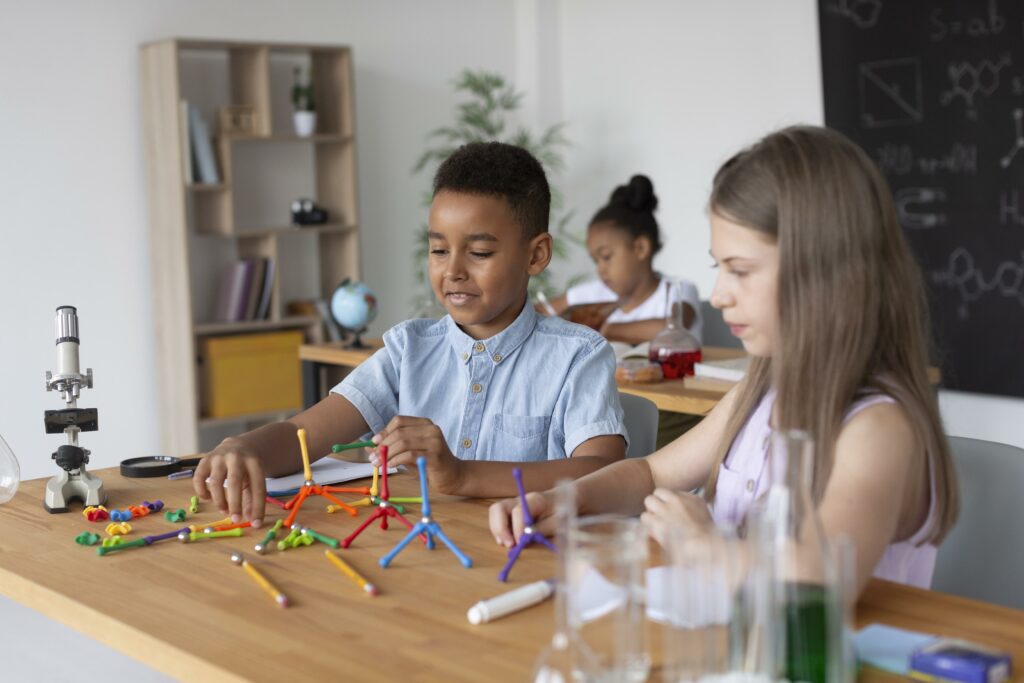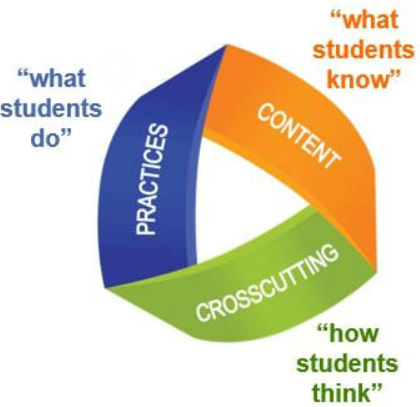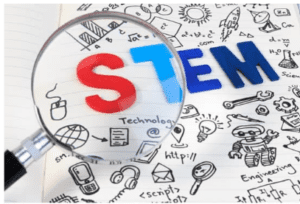“This is the best day of my life!” shouted one of my sweet, energetic third grade students from across the elbow-to-elbow packed auditorium in the winter of 2016. I gave him a thumbs-up, huge smile and took in the moment as he grinned back at me with enthusiasm. We had just watched The Cloud Ceremony at The Center of Science and Industry (COSI) in downtown Columbus. I was a first year third grade teacher, braving the uncharted territory of a mid-January field trip with my 29 students. If you were sitting next to me on that snowy afternoon you would’ve just immediately heard the chorus of collective “Wowws!” as those bright eyes watched the COSI instructors; cloaked in white lab coats and gigantic science goggles pour liquid nitrogen into a vat of boiling water to create instant clouds. Immediately, the clouds streamed out of the container and sailed across the room, enveloping my students’ little faces. They shrieked with excitement, disbelief and “I want to try’s!!!” During COSI’s Weather LIVE show, the presenters had engaged my students in the science behind how clouds are formed and brought them into the process of watching science come alive. Those reactions, the follow up questions and disappointment in having to exit the auditorium at the end of the presentation were just the beginning.
Throughout the day, I watched my John Glen obsessed student race into the planetarium exhibit with his group, my history lovers eagerly circle the 6-foot long mechanical T-rex model, my bookworms start devouring the didactic wall panels about energetic waves in the ocean exhibit, the daredevils excited to try the high wire unicycle while learning about the physics of balances and levers, and my reluctant learners hesitantly touch the plasma ball, witnessing the magic behind electrodes and light waves.
The joy in the building was palpable, and when we returned to school that day, my students were still buzzing from the metaphorical high of their day. Yet, I couldn’t help but feel a pang of sadness run through me. That was a day my students would remember for a long time and an experience that I knew many of them might not have again. They brought back with them an energized love for science, problem solving and exploration. Third grade science for the year was finished by this point; we had wrapped up right before winter break. We had to cram a year’s worth of material into the first two quarters in order to make time for state testing preparation in the new year. The consequence of that was having to take shortcuts in our activities to hit all of Ohio’s science standards. Labs, demonstrations, and creative projects were rushed, so as not to miss any important topics. Worksheets were unfortunately the quickest way to gather data and we did the best we could, with what we had.
Reminiscing on this memory, I still get that wave of sadness running through me, because I know that the magic those students experienced that day should be commonplace in our classrooms. No, we can’t ask our administrators to resurrect a life-sized T-Rex model on our playgrounds and no, I’m certainly not saying teachers don’t create their own magic in their classrooms on a daily basis. What I am talking about though, is the hands-on, immersive, explorative, trial and error, fundamental process of actually doing science. What’s holding our classrooms back from garnering that kind of energy surrounding science on a daily basis? How do our standards play a role in the way the subject matter is approached? Coupled with the funding/resources and time and prioritization, more classrooms could look that way.

The International Competition
The education landscape is constantly evolving; new data is collected, analyzed and released, emerging instructional techniques develop alongside technological advances, and trends come and go. One notable saying that is floating around in the education world currently in relation to literacy instruction is “when you know better, you do better.” With once renowned forces in elementary literacy pedagogy like Lucy Calkins and Fountas & Pinnell being held to the fire for their harmful and inaccurate reading and writing instructional practices, many districts across the country are doing just that: acknowledging the past harm done and moving forward with plans in place to do better. What can be said of our science standards and curriculum, or lack thereof in comparison? Considering the heavy emphasis placed on test preparation in American schools, our science and math scores should stack up well in the international competition. I think the following data is very telling.
One of the most significant international tests is the Programme for International Student Assessment (PISA), which measures reading abilities, math and science literacy and other fundamental skills among 15-year-old students across numerous developed nations. According to the 2015 PISA test results, United States students ranked an unremarkable 38th out of 71 countries in math and 24th in science. (Pew Research Center). If we look at data from the National Assessment of Educational Progress, a nationwide testing effort, the average 2015 math and science scores were again, unimpressive. On a scale of 0-500, the average fourth grade NAEP math score was 240, and the average eighth grade score was 282. In science, only 38% of fourth graders and 34% of eighth graders were ranked proficient or better in science. (Pew Research Center). In an additional 2015 Pew Research Center nationwide survey, only 29% of Americans rated the U.S K-12 STEM education as above average or the best in the world. But what about the experts? Scientists took a companion survey from the American Association for the Advancement of Science and a mere 16% called the U.S. K-12 STEM education above average. (Pew Research Center).
What we can gather just from that small sample is that what we’ve been doing isn’t working. In 1996, the National Research Council produced the National Science Education Standards (NSES), a set of goals for student knowledge and assessment. According to National Academies, “These standards reflect the principles that learning science is an inquiry-based process, that science in schools should reflect the intellectual traditions of contemporary science, and that all Americans have a role in improving science education.” Sound familiar? With this initiative, the NSES attempted to offer a cohesive vision of what scientific literacy should look like within our diverse society. A lofty, but important goal, nonetheless. However, by the time No Child Left Behind came on the education scene in 2001, the Common Core was on the horizon and the science spotlight was dimming quickly.
The U.S Department of Education states that public education is primarily a State and local responsibility, a decision that comes with considerable pros and cons. State science standards, instruction, assessment and overall student learning vary wildly across the country. Some states adopted the NSES while other State departments developed their own standards. Either way, the unfortunate reality is that American students are not and have not been learning the content and skills they need to compete in a global market. In a society that heavily prioritizes technological advancements, our STEM education has been lagging behind for quite some time. I think the same logic to literacy education reform can be applied to the state of our science education in the United States:
If we know better, let’s do better.
What to know about the Next Generation Science Standards
In April of 2013, the National Science Education Standards were replaced by the Next Generation Science Standards (NGSS), which were released in another effort to create a nationally shared vision and rigorous K-12 science education criterion. NGSS are simply standards—benchmarks and best practices for teachers to follow and guide their instruction. They are not new curriculum, assessments or a set of lesson plans and the approach and methods teachers may use to achieve the goals are intentionally vague. The NGSS allows for individual teacher flexibility and local input.

The NGSS standards are based largely on the 2011 National Research Council Report, A Framework for K-12 Science Education: Practices, Crosscutting Concepts and Core Ideas. The NGSS framework is built on three equally important pillars to learning science and offers educators the chance to design learning experiences that spark interest, creativity and prepare students for life beyond the classroom.
Disciplinary Core Ideas
The core ideas of NGSS provide a focused organization to the standards and an overarching importance across all scientific disciplines. The remaining pillars of NGSS guide an exploration process to the four domains of science: the physical sciences; the life sciences; the earth and space sciences; and engineering, technology, and applications of science. These core building blocks should carry students throughout their K-12 science education with the understanding that the material they learn in elementary school will be revisited in middle and high school with a deeper level of complexity.
Crosscutting Concepts
The Crosscutting Concepts of NGSS are a key element that emphasizes the importance of recognizing the connections between the different scientific disciplines. NGSS incorporates crosscutting concepts such as cause and effect, system models, energy and matter, scale and proportion, among others. For example, middle school students might need to explain photosynthesis, but also model energy flows, and then contend how these changes impact an ecosystem. Through these interwoven concepts, which provide a context for their knowledge to blossom, students should hopefully gain a more comprehensive, real world understanding of the scientific domains.
Science & Engineering Practices
NGSS involves the expectation that students will come to know and understand how scientists work. Through comprehending and interpreting data sets, following trends, or creating and informing a hypothesis, students should be prepared to take on the challenges of the workforce whether they pursue a career in a STEM field or follow another career path. Students should be able to translate the STEM principles of NGSS to many aspects of their everyday lives.
21st Century Science Education for the Next Generation
The Next Generation Science Standards is a multi-state initiative, and as of November 2022, 20 states and the District of Columbia have adopted the NGSS (36% of U.S students), while 44 states (71% of U.S students) have standards that are aligned with the NGSS Framework.
The NGSS emphasizes higher order thinking across all scientific content bands, reshaping the way students approach their learning. In short, NGSS pursues a dramatic shift from the memorization of facts and equations to three-dimensional learning that requires students to analyze, evaluate, and create. Additionally, all three dimensions are interwoven into the standards, requiring students to incorporate practices, disciplinary core ideas, and crosscutting concepts into everything they learn and accomplish. Perhaps the most fundamental way NGSS can impact students for the better is emphasizing the weight science holds in our everyday lives; pushing students to think and behave like scientists and engineers, not just learn about them second hand.
Ohio’s Approach to the Standards
The NGSS have made their way into Ohio’s classrooms in various forms. Currently, The Ohio Department of Education provides educators with a model curriculum for Math and English Language Arts that was put in place after the adoption of Ohio’s Learning Standards in 2017. “The purpose of Ohio’s model curriculum is to provide clarity to the standards, as well as assist educators in planning and implementing their local curriculum” (Ohio Department of Education). Ohio’s Learning Standards for Science were revised in the 2018-2019 school year as part of a periodic review.
According to the Ohio Department of Education, “The structure of Ohio’s Learning Standards for Science is significantly different from NGSS, but the research that provided the framework from which each was developed is the same.” They encourage teachers to use NGSS as a support for their existing instruction. As of 2022, Ohio is currently a “Lead State” in future adoption of the NGSS standards. Through their status as such, the ODE is recognizing the importance of familiarizing students with the future of science education. And while the future of the Next Generation Science Standards in Ohio looks bright, the decision to opt in or out of the NGSS is still ultimately subject to final input at the state and local level.
Next Gen’s Impact on Scientific Literacy
Our understanding of science affects almost all areas of our personal and civic lives. It impacts how we approach our health and wellness, our reproductive choices, how we take care of our planet, interact with the environment, and even how and why we vote. Scientific literacy has quickly become a fundamental 21st century skill, as more and more jobs require employees to be able to reason, problem solve, think critically and use technology with ease.

Our citizens need an understanding of the basic, central scientific principles to vote on some of the most important and controversial political issues our country is facing today–from climate change, offshore drilling, coastal protection, renewable energy sources, hydraulic fracturing, and environmental conservation, to name a few. Everyone needs to use scientific information to make informed choices in their everyday lives. Unfortunately, for many of our disadvantaged citizens, science education is largely overlooked. American schools are forced to favor reading and math through an accountability system that does not always adequately prepare our students for the social and environmental challenges they will face in the future. Additionally, to keep pace in global markets, the United States must be investing in creating a scientifically and technically literate workforce.
All of us have a stake, individually and as a society, in scientific literacy.
Ohio Energy Project & NGSS
Science is much more about how we teach rather than what we teach and NGSS aims to encourage that practice. It is a combination of the content, how teachers approach the content and what they do with it. Teachers should have the tools to be able to bring experiences into their classrooms to help students ask and answer questions about scientific phenomena. Science education equips students with the necessary skills to participate in a competitive workforce and global economy and STEM careers play an enormous role in that. According to the National Science Foundation, “The number of workers in S&E occupations grew from about 1.1 million in 1960 to about 5.8 million in 2011. This represents an average annual rate of 3.3%, greater than the 1.5% growth rate for the total workforce.”
Science at its core, is exploratory; it is one way of examining the world, diving into inquiry and observation, trial and error, and the process of problem solving. Science is not rote memorization, an accumulation of knowledge or basic information recall. Shouldn’t our science standards reflect what we know to be true about science? That students need to be active participants in their education, applying what they’re learning in the context of answering tough questions. They need the foundation to ask those tough questions and want to learn more about what’s going on so they can understand the science behind it.
Ultimately, learning is a process, an ever-changing, fluid combination of experiences that must have collaborative involvement of both teachers and students. The more that students are involved in their learning, the greater their investment. In order for students to understand how the natural and physical world work, they need the critical thinking skills to spark their curiosity.
For 35 years Ohio Energy Project has been lighting the match for teachers and students to spark their curiosity about energy. The Next Generation Science Standards framework reflects much of what OEP has been dedicated to for the past few decades. The Next Generation Science Standards are still young and their future in our American classrooms is still pending, but Ohio Energy Project will continue to be dedicated to making immersive, exploratory science a priority and a reality in Ohio’s classrooms.
In the third and final piece of this three-part blog series, Ohio Energy Project’s impact on Ohio classrooms will be highlighted. OEP has been a driving force in energy literacy for many years and is looking eagerly to the future at what’s next for us.
References
DeSilver, D. (2020, August 21). U.S. students’ academic achievement still lags that of their peers in many other countries. Pew Research Center.
https://www.pewresearch.org/fact-tank/2017/02/15/u-s-students-internationally-math-science/
Education Rankings by Country 2023. (n.d.). https://worldpopulationreview.com/country-rankings/education-rankings-by-country
Energy Literacy. (n.d.). NSTA. https://www.nsta.org/science-scope/science-scope-julyaugust-2022/energy-literacy
Lead State: Ohio | Next Generation Science Standards. (n.d.). https://www.nextgenscience.org/lead-state-ohio
Loewus, L. (2020b, December 1). U.S. Achievement Stalls as Other Nations Make Gains. Education Week.
Loewus, L. (2021, March 18). Next-Generation Science Tests Slowly Take Shape. Education Week.
https://www.edweek.org/teaching-learning/next-generation-science-tests-slowly-take-shape/2017/05
National Academy of Sciences, National Academy of Engineering, and Institute of Medicine. (2005, October 12). Rising Above the Gathering Storm: Energizing and Employing America for a Brighter Economic Future. The National Academies Press.
National Science Education Standards. (n.d.). https://www.csun.edu/science/ref/curriculum/reforms/nses/
National Research Council. (1996, January 1). National Science Education Standards. The National Academies Press. https://nap.nationalacademies.org/catalog/4962/national-science-education-standards
Ohio’s Learning Standards and Model Curriculum for Science. (n.d.). Ohio Department of Education. Retrieved January 4, 2023, from
https://education.ohio.gov/Topics/Learning-in-Ohio/Science/Ohios-Learning-Standards-and-MC
State and District Implementation | Next Generation Science Standards. (n.d.).
https://www.nextgenscience.org/state-and-district-implementation/state-and-district-implementation
STEM Education Data and Trends. (n.d.).
https://www.nsf.gov/nsb/sei/edTool/data/workforce-01.html
The Nation’s Report Card. (n.d.).
https://www.nationsreportcard.gov/
The State of U.S. Science and Engineering 2020 | NSF – National Science Foundation. (n.d.). Www.ncses.nsf.gov. Retrieved January 4, 2023, from
https://www.ncses.nsf.gov/pubs/nsb20201/u-s-and-global-education
US Department of Education (ED). (n.d.). Federal Role in Education.
https://www2.ed.gov/about/overview/fed/role.html
Images retrieved from:
Freepik.com
What are the Next Generation Science Standards (NGSS)? – Mrs. Bildner’s Science Page (weebly.com)
Amanda Breckenridge, M.Ed. is a former elementary teacher turned education program coordinator and freelance writer.
Abbey Thomas


